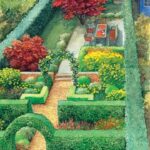Are you tired of mowing, watering, and fertilizing a traditional grass lawn? Many homeowners are rethinking the idea of a traditional lawn and opting for grass-free landscapes instead. This growing trend of landscape ideas no grass is gaining popularity for several reasons. Not only does it offer environmental benefits, but it also provides a unique and low-maintenance alternative to the typical green lawn.
One of the primary reasons why people are choosing grass-free landscapes is the desire to reduce water usage and minimize the environmental impact of traditional lawns. With droughts becoming more common in many regions, xeriscaping has become a popular option. This approach involves using drought-tolerant plants and native vegetation to create beautiful, sustainable landscapes that require significantly less water than traditional lawns.
In addition to xeriscaping, other types of grass-free landscapes include rock gardens and mulch beds. Rock gardens incorporate different types of rocks and boulders for a visually striking landscape, while mulch beds provide a low-maintenance alternative to grass.
These options not only reduce water usage but also eliminate the need for constant mowing and upkeep. As people seek alternatives to traditional lawns, creative hardscaping ideas such as pavers, outdoor living spaces, water features, planting flower and shrub borders, vertical gardening and green walls have been gaining momentum as modern additions to landscape design without grass.
Types of Grass-Free Landscapes
There are various alternatives to traditional grass lawns that can be both visually appealing and environmentally friendly. Xeriscaping is one popular option, which involves the use of drought-tolerant plants and native vegetation to create a landscape that requires minimal water. This not only reduces water usage but also helps preserve the natural beauty of the local environment.
Rock gardens are another grass-free landscaping choice, incorporating different types of rocks and boulders to add texture and interest to outdoor spaces. Mulch beds are also gaining popularity as they offer a low-maintenance alternative to grass, providing a neat and uniform look while also helping with water retention in the soil.
Xeriscaping has become increasingly popular due to its sustainability and water-saving benefits. In areas with limited water resources or periods of drought, xeriscaping offers an attractive solution for homeowners looking to maintain an aesthetically pleasing landscape without relying on traditional grass lawns. Additionally, rock gardens and mulch beds are practical options for those seeking low-maintenance landscaping ideas no grass, as they require less upkeep than traditional lawns while still offering visual interest.
Incorporating these grass-free landscaping options not only contributes to reducing environmental impact but also provides homeowners with sustainable and cost-effective alternatives for maintaining their outdoor spaces. As more people seek ways to create beautiful landscapes that require less maintenance and resources, the popularity of grass-free landscaping continues to grow. With the right design choices and proper planning, homeowners can enjoy unique and eco-friendly outdoor environments without the need for traditional grass lawns.
| Grass-Free Landscaping Type | Key Features |
|---|---|
| Xeriscaping | Drought-tolerant plants, native vegetation, minimal water usage |
| Rock Gardens | Different types of rocks and boulders incorporated for texture and interest |
| Mulch Beds | Low-maintenance alternative with neat appearance and soil water retention benefits |
Creative Hardscaping Ideas
Pavers and Pathways
One of the most popular landscape ideas no grass is the use of pavers and pathways to create visually appealing walkways and patios. With a wide variety of materials such as concrete, brick, or natural stone available, homeowners can customize their outdoor spaces to fit their aesthetic preferences.
Pavers can be arranged in different patterns to add visual interest, while pathways can lead visitors through the garden or connect different areas of the yard. These hardscaping elements not only reduce the need for grass but also provide functional and durable surfaces for outdoor activities.
Outdoor Living Spaces
Designing cozy areas for relaxation and entertaining is another key aspect of creating a grass-free landscape. This could include the installation of an outdoor kitchen, a seating area with a fire pit, or even an outdoor dining space. By incorporating elements such as comfortable seating, lighting, and decorative features like pergolas or trellises, homeowners can transform their yards into inviting spaces for socializing and enjoying the outdoors without relying on traditional grassy areas.
Water Features
For those seeking unique focal points for their landscaping, water features such as ponds, fountains, or waterfalls can provide a striking visual element in a grass-free landscape. These features not only add visual interest but also contribute to the overall tranquility and ambiance of the outdoor space.
Whether it’s a small fountain in a corner of the yard or a larger pond with aquatic plants and fish, water features can enhance the beauty and appeal of a landscape without the need for traditional grass maintenance.
Planting Flower and Shrub Borders
When it comes to landscape ideas no grass, planting flower and shrub borders is a popular option for those looking to add color and vibrancy to their outdoor spaces without the need for traditional lawns. Selecting colorful flowers and shrubs can create visually appealing borders that enhance the overall aesthetic of the landscape. Additionally, designing layered plantings can add depth and texture, making the space more visually interesting.
One of the major benefits of opting for flower and shrub borders in a grass-free landscape is the reduced maintenance required. Unlike traditional lawns, which need regular mowing and upkeep, flower and shrub borders require minimal maintenance once established. This makes them an attractive option for those looking to reduce the time and effort spent on yard work.
In terms of environmental benefits, planting flower and shrub borders can contribute to biodiversity by attracting pollinators such as bees and butterflies. By choosing native plant species, homeowners can also support local ecosystems while reducing water consumption, as these plants are typically well-adapted to local climate conditions.
| Benefit | Explanation |
|---|---|
| Reduced Maintenance | Flower and shrub borders require minimal upkeep once established. |
| Environmental Benefits | Biodiversity is increased by attracting pollinators such as bees and butterflies; also reduces water consumption through use of native plant species. |
Vertical Gardening and Green Walls
Utilizing Vertical Space
When it comes to landscape ideas no grass, vertical gardening is a great option for adding greenery to your outdoor space. By utilizing vertical space, you can include plants and foliage without the need for traditional lawns. This approach not only maximizes the use of limited outdoor space but also adds visual interest to your landscape.
One popular method of vertical gardening is the use of trellises and arbors to support climbing plants such as vines, flowers, or vegetables. These structures not only provide a functional way to grow plants in a small area but also create a beautiful and natural focal point in the landscape.
Building Green Walls
Another modern and space-saving alternative to traditional lawns is the incorporation of green walls into your landscaping design. Green walls, also known as living walls, are vertical structures covered in plants that can be installed on exterior walls or freestanding frames. These green installations not only add an artistic touch to your outdoor space but also offer numerous environmental benefits such as improving air quality, reducing noise pollution, and providing insulation for buildings.
In addition to their aesthetic appeal, green walls are ideal for those looking to introduce more greenery into their landscapes without the need for traditional grass. They offer a creative solution for homeowners who want to maximize their outdoor spaces while minimizing maintenance requirements. Whether used as a standalone feature or integrated into existing landscaping, green walls can transform any outdoor area into a vibrant and sustainable environment.
With these innovative options for vertical gardening and green walls available, homeowners can create stunning grass-free landscapes that are both visually appealing and environmentally friendly. Whether you’re looking to make the most of limited outdoor space or simply want to rethink traditional lawns, incorporating these landscape ideas no grass can transform your yard into a thriving oasis of greenery.
Functional Landscape Design
Incorporating edible plants and herbs into your landscape can not only add visual interest but also provide a sustainable source of fresh produce. Consider including raised garden beds or vertical planters to grow vegetables and herbs such as tomatoes, peppers, basil, and mint. Not only will this add a functional element to your landscape, but it will also promote healthy eating and self-sufficiency. Here are some ideas for incorporating edible plants into your grass-free landscape:
- Raised Garden Beds: Construct raised garden beds using materials such as wood or composite lumber. This will allow you to control the soil quality and drainage while creating designated areas for growing vegetables.
- Vertical Planters: Install wall-mounted or freestanding vertical planters to maximize space and grow a variety of herbs and small vegetables. This is an innovative way to utilize vertical space while adding a striking visual element to your landscape.
- Fruit Trees and Berry Bushes: Consider planting fruit trees such as apple, pear, or cherry, along with berry bushes like blueberry or raspberry to add height and diversity to your landscape. These options can provide an abundant harvest while minimizing the need for traditional lawn maintenance.
Additionally, functional landscape design can involve creating play areas for children and pets without the need for traditional grass. Instead of a large open lawn, consider installing outdoor play equipment such as swings, slides, or climbing structures in designated areas of your landscape.
Designate specific areas for pets by installing pet-friendly features like artificial turf patches or gravel-filled zones where pets can play without damaging delicate plants. By incorporating these elements into your landscape design, you can create a versatile outdoor space that serves multiple purposes without the need for traditional grass.
Overall, functional landscape design offers numerous opportunities to rethink traditional lawns and explore alternative options that are both visually appealing and purposeful. Whether it’s through edible gardening or creating play spaces without grass, there are plenty of ways to create a diverse and sustainable landscape that meets the needs of your household.
Maintenance and Care Tips
Maintaining a grass-free landscape requires different considerations than traditional lawn care. One of the main advantages of grass-free landscaping is the reduced maintenance it offers, but it still requires some level of care to keep it looking its best. Here are some tips and guidelines for maintaining and caring for a landscape with no grass:
- Regularly check for weeds and remove them to prevent them from taking over the landscape
- Keep an eye on the moisture levels of the soil, especially for drought-tolerant plants
- Prune and trim plants as needed to maintain their shape and prevent overgrowth
- Apply mulch regularly to retain moisture, suppress weeds, and provide a finished look to the landscape
- Periodically inspect and clean hardscaping elements such as pathways, patios, or water features
Incorporating low-maintenance plants that thrive in your specific climate can also help minimize the amount of care required for your grass-free landscape. Choosing native vegetation and drought-tolerant plants can reduce the need for watering and overall maintenance.
It’s important to remember that while grass-free landscapes may require less maintenance than traditional lawns, they still need attention to ensure they remain healthy and visually appealing. By following these maintenance and care tips, you can enjoy a beautiful landscape without the need for traditional grass.
Cost Analysis and Budget-Friendly Options
In conclusion, the trend of grass-free landscaping is gaining popularity for a variety of reasons, including environmental benefits and reduced maintenance. From xeriscaping to creative hardscaping ideas, there are numerous options available for individuals looking to create a landscape without traditional grass. By exploring alternatives such as rock gardens, mulch beds, and water features, homeowners can design a visually appealing outdoor space that requires less water and upkeep.
Additionally, incorporating vertical gardening, edible plants, and play areas for children and pets can add functionality to the landscape while still maintaining a grass-free environment. This not only reduces the need for mowing and watering but also provides opportunities for creativity and individuality in landscaping design. Implementing these landscape ideas no grass can also have cost-saving benefits in the long run, making it a budget-friendly option for many homeowners.
In the end, with careful planning and consideration of various landscape options, creating a grass-free outdoor space is not only possible but can be an environmentally conscious and aesthetically pleasing choice. By embracing these cost-effective alternatives and low-maintenance solutions, individuals can transform their landscapes into beautiful and sustainable areas for relaxation and enjoyment.
Frequently Asked Questions
How Can I Landscape My Yard Without Grass?
One way to landscape your yard without grass is to create a hardscape using materials like gravel, pavers, or stone. You can design walkways, patios, and seating areas to add visual interest and functionality to your outdoor space. Additionally, incorporating mulch beds, ground cover plants, or native landscaping can help fill in the space without relying on traditional grass lawns.
How Do You Cover Areas Where Grass Won’t Grow?
When grass won’t grow in certain areas of your yard, you can consider using alternative ground covers like moss, clover, or sedum which are better suited for shady or dry conditions. Another option is to install mulch or gravel beds that require minimal maintenance and can provide an attractive contrast to the rest of your landscaping.
Additionally, utilizing raised beds for gardening or creating focal points with decorative elements can help divert attention from bare patches.
How Can I Decorate My Yard Without Plants?
To decorate your yard without plants, you can utilize various non-plant elements such as outdoor furniture, sculptures, water features, or decorative lighting. Adding paths and architectural features like arbors or pergolas can also contribute to the aesthetic appeal of the space.
Moreover, incorporating hardscaping materials and creating designated functional zones for activities like dining or relaxation can enhance the overall look of your yard without relying on traditional plantings.

Welcome to my gardening blog! I am passionate about plants and enjoy sharing my knowledge and experiences with others. In this blog, I will write about everything related to gardening, from tips on how to get started to updates on my own garden projects.





